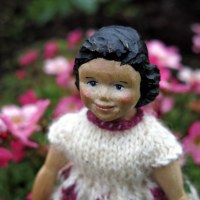Immersed in the Impressionists – Part Three
If ever you mention books from the 1800s to people, what is their most likely response?
“You know they were paid by the word, that’s why there’s so much description.”
Well, that’s not really true.
I like books from the 1800s, and have read a lot of them – Dickens, Eliot, Trollope, Austen. But I often feel the real story is not being told so much as hinted at. The allusions and innuendos go over my head. And what really trips me up is the sentence structure – all those qualifiers, dependent clauses, and double negatives. As in this sentence (feel free to skip ahead) –
The Honourable John was not, perhaps, so much accustomed to the ready use of his tongue as was his honourable brother, seeing that it was not his annual business to depict the glories of the farmers’ daughters: at any rate, on this occasion he seemed to be at some loss for words; he shut up, as the slang phrase goes, and make no further allusion to the necessity of supplying young Gresham with a proper string of hunters.
– Doctor Thorne, Anthony Trollope
I can translate that – “John realized that he was not as glib as his brother, and had accidentally insulted someone, so he stopped talking about the subject.” But when all the action is stated so indirectly, it gets tiring to read.
But as I was following my interest in the Impressionists, the name of an author of that era kept coming up – Émile Zola. I had never read anything by him so I decided to give him a try. And I loved him! His style of writing seems so modern, so easy to follow.
I started with The Ladies’ Paradise (Au Bonheur des Dames), which is a fictionalized account of the huge department stores that arose in Paris, and how they affected the small businesses that had been the norm. Since I have also been watching Mr. Selfridge on Masterpiece Theatre, I enjoyed this look behind the scenes at a department store.
It opens with the main character, Denise, looking in the shop windows of the Ladies’ Paradise, and seeing –
…an exhibition of silks, satins, and velvets, arranged so as to produce, by a skillful artistic arrangement of colors, the most delicious shades imaginable. At the top were the velvets, from a deep black to a milky white: lower down, the satins – pink, blue, fading away into shades of a wondrous delicacy;, still lower down were the silks, of all the colors of the rainbow, pieces set up in the form of shells, others folded as if round a pretty figure, arranged in a life-like manner… At the back a large sash of Bruges lace, of considerable value, was spread out like an altar-veil, with its two white wings extended; there were flounces of Alençon point, grouped in garlands; then from the top to the bottom fluttered, like a fall of snow, a cloud of lace of every description – Malines, Honiton, Valenciennes, Brussels, and Venetian-point.
An author that actually knows textiles!!! *happy sigh*
I was hooked by that opening scene, and I wasn’t disappointed by the rest of the book.
Denise is not your typical 1800s female character – she is a working girl, not a lady of leisure. She is neither a doormat like Little Nell, nor a self-centered weakling like Madame Bovary. She is that rare character that can see more than one side of an issue. She loves the Ladies’ Paradise and thinks it represents the future, but she also sympathizes with those whose businesses are being hurt by it.
I was fascinated with the business details as the Paradise constantly expands- the logistics of handling the merchandise, from its initial arrival through display, sale, and delivery by horse-drawn van; the innovations such as using loss leaders and accepting returns; the deals to squeeze suppliers and turn the inventory. All of the attempts to minimize cost and maximize margins would fit right into today’s world.
I enjoyed the way that the recurring minor characters – employees conniving for promotions, and high-profile customers (including a wealthy kleptomaniac, a savvy bargain hunter, and a shopping addict) presented different facets of running the business.
Next I read His Masterpiece (L’Œuvre), which is an account of an artist trying to achieve recognition. Zola had known Cézanne from childhood, and created a fictional character, Claude Lantier, who was a combination of Manet and Cézanne. He also included a writer character that was based on himself. Manet was already dead by the time the book was published, but Cézanne stopped speaking to Zola over the book.
It is not a happy book, but if you are interested in the Impressionists, it is worth reading just for the scenes of the politicking going on among the artists and jurors of the Paris Salon.
What I really loved best were the descriptions of Paris.
…this, the heart of Paris, had taken full possession of him. The splendid evening seemed to widen the horizon. There were patches of vivid light, and of clearly defined shadow; there was a brightness in the precision of each detail, a transparency in the air, which throbbed with gladness. And the river life, the turmoil of the quays, all the people, streaming along the streets, rolling over the bridges, arriving from every side of hat huge cauldron, Paris, steam there in visible billows, with a quiver that was apparent in the sunlight. There was a light breeze, high aloft a flight of small cloudlets crossed the paling azure sky, and one could hear a slow but mighty palpitation, as if the soul of Paris here dwelt around its cradle.
– His Masterpiece, Émile Zola
I think those words complement the Impressionists’ paintings of Paris.
Zola considered himself to be writing “Naturalist” novels, where he just observed the effects of society on individuals. He thought that literature could be like a type of scientific experiment. What I remember from my college literature classes is that this movement drew a lot of sharp criticism for focusing on the lower classes and on the ugly realities of life. Apparently a description like this one was just too much for readers in the 1800s-
After shaking off the water, Claude went up the deep archway entrance, to a courtyard, where the light was quite greenish, and where there was a dank,musty smell, like that at the bottom of a tank. There was an overhanging roofing of glass and iron at the foot of the staircase, which was a wide one, with a wrought-iron railing, eaten with rust.
– His Masterpiece, Émile Zola
It’s ironic to me that Zola and critics focused so much on “scientific” descriptions like that one, because to me a lot of his work is over-the-top romantic. In the last chapter of The Ladies’ Paradise, as Denise is deciding on her destiny, there are pages of her running through all the departments of the store, every last one of which has only pure white merchandise on display. It was a little too symbolic, even for me.
But over all, I feel like Zola’s choice of topics, along with his straightforward writing style, gives me a clearer picture of the era than any modern historical novel could.
















I’ve always been curious about Zola, and you did a good sell – I don’t know when I’ll have much reading time again, but he’s now on my list. As for the dense sentences: that’s basically what “elegant” Greek and Latin look like, so it might be a side-effect of the 19th c. education system, which had so much emphasis on rhetoric as it was done in antiquity. Just a guess, but it wouldn’t surprise me.
I love books from the 1800s for their plots – to me they seem so much more varied than the plots of modern books. Although maybe I am just choosing formulaic books from our time. But I definitely have to be in the right mood to read them – after a while I am thinking, “Get to the point!” or “Forget your silly upper-class notions of living on your family income and get a job!” or “Forget those stupid class differences and just come to America! You can marry the butler’s daughter over here and NO ONE CARES!”
By the way I bought Fagles’ Odyssey for 50 cents at our library sale. So I am prepared if we do a read-along!
I need to read Zola now! You know my brother was named after him? 🙂
Wow! I would be interested to know what it was about Zola that made your parents want to commemorate him that way.
I think you would like The Ladies’ Paradise – at least the parts that talk about the little shops and how they were slowly going under due to the Big Box stores of their day. There are also some conversations that the owner has with his employees, explaining why it’s better to turn the merchandise many times at a small profit, instead of holding it – and about his plans to get women in his power by making them want stuff they never even saw before! – that are still so relevant today.
Thank you so much for the recommendation! Just added it to my reading list 🙂